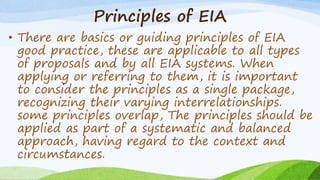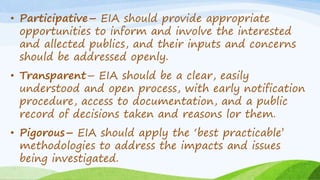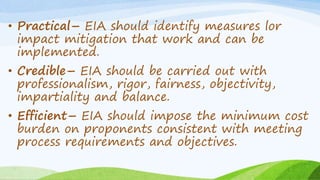3rd EIA Law, Policy and Institutional Arrangements.pptx
- 1. Environmental Impact Assessment (EIA) Abdiwali Abdullahi BSc in Public Health, MSc in Public Health(HM) 06 March, 2021
- 2. Benefits of EIA: ? The benefits of EIA can be direct, such as the improved design or location of a project, or indirect, such as better quality EIA work or raised environmental awareness of the personnel involved in the project. In these cases, there will be with flow-on effects in their future work. As mentioned above, these potential gains from EIA increase the earlier the process is applied in the design process.
- 3. In general, the benefits of EIA include: 1. Better environmental planning and design of a proposal: Carrying out an EIA entails an analysis of alternatives in the design and location of projects. This can result in the selection of an improved technology, which lowers waste outputs or an environmentally optimum location for a project. A well-designed project can minimize risks and impacts on the environment and people, and thereby avoid associated costs of remedial treatment or compensation for damage.
- 4. 2. Ensuring compliance with environmental standards. ? Compliance with environmental standards reduces damage to the environment and disruption to communities. It also avoids the likelihood of penalties, fines and loss of trust and credibility.
- 5. 3. Savings in capital and operating costs ? EIA can avoid the undue costs of unanticipated impacts. These can worsen if environmental problems have not been considered from the start of proposal design and require modification later. An Ī«anticipate & avoidĪ» approach is much cheaper than Ī«react & cureĪ». Generally, changes which must be made late in the project cycle are the most expensive
- 6. 4. Reduced time and costs of approvals of development applications. ? If all environmental concerns have been taken into account properly before submission for project approval, then it is unlikely that delays will occur as a result of decision-makers asking for additional information or alterations to mitigation measures.
- 7. 5. Increased project acceptance by the public. ? This is achieved by an open and transparent EIA process, with provision of opportunities for public involvement that are appropriate to the people who are most directly affected by and interested in the proposal.
- 8. KEY PRINCIPLES OF EIA ? To date, EIA has been applied primarily at the project-level. This 'first generation' process is now complemented by SEA of policies, plans and programmes, and both EIA and SEA are being adapted to bring a greater measure of 'sustainability assurance' to development decision making. These trends have brought new perspectives on what constitutes EIA good practice and effective performance.
- 9. ? Recently, a number of reviews of these issues have been undertaken, including the International Study of the Effectiveness of Environmental Assessment. It described basic and operational principles for the main steps and activities undertaken in the EIA process. The International Association for Impact Assessment (IAIA) and the Institute of Environmental Management and Assessment (IEMA) have drawn on these to prepare a statement of EIA 'best practice' for reference and use by their members.
- 10. The Effectiveness Study identified three core values on which the EIA process is based: ? Integrity- the ElA process should meet internationally accepted requirements and standards of practice; ? Utility- the ElA process should provide the information which is sufficient and relevant for decision-making; and ? Sustainability- the EIA process should result in the implementation of environmental safeguards which are sufficient to mitigate serious adverse effects and avoid irreversible loss of resource and ecosystem functions.
- 11. Principles of EIA ? There are basics or guiding principles of EIA good practice, these are applicable to all types of proposals and by all EIA systems. When applying or referring to them, it is important to consider the principles as a single package, recognizing their varying interrelationships. some principles overlap, The principles should be applied as part of a systematic and balanced approach, having regard to the context and circumstances.
- 12. Guiding principles of EIA good practice ? Purposive©C EIA should meet its aims of informing decision making and ensuring an appropriate level of environmental protection and human health. ? Focused©C EIA should concentrate on significant environmental effects, taking into account the issues that matter. ? Adaptive©C EIA should be adjusted to the realities, issues and circumstances of the proposals under review.
- 13. ? Participative©C EIA should provide appropriate opportunities to inform and involve the interested and allected publics, and their inputs and concerns should be addressed openly. ? Transparent©C EIA should be a clear, easily understood and open process, with early notification procedure, access to documentation, and a public record of decisions taken and reasons lor them. ? Pigorous©C EIA should apply the Ī«best practicableĪ» methodologies to address the impacts and issues being investigated.
- 14. ? Practical©C EIA should identify measures lor impact mitigation that work and can be implemented. ? Credible©C EIA should be carried out with professionalism, rigor, fairness, objectivity, impartiality and balance. ? Efficient©C EIA should impose the minimum cost burden on proponents consistent with meeting process requirements and objectives.
- 15. Law, Policy and Institutional Arrangements
- 16. ? EIA is an evolving process. ? When establishing or strengthening an EIA system, there is an opportunity to build upon the experience of others and to move towards legal and policy frameworks that support environmental sustainability. ? EIA systems have become progressively more broadly based, encompassing a wider range of impacts, higher levels of decision-making and new areas of emphasis. About EIA Systems
- 17. Stakeholders Involved ĪŁ ? Proponents: ? Understandably, proponents will wish to shape the proposal to give it the best chance of success. ? Often, this involves trying to create public understanding and acceptance of the proposal through the provision of basic information. ? More creatively, project design can be improved through using public inputs on alternatives and mitigation and understanding local knowledge and values.
- 18. Stakeholders Involved ĪŁ ? Government agencies: ? The government agencies involved in the EIA process will want to have their policy and regulatory responsibilities addressed in impact analysis and mitigation consideration. ? For the competent authority, an effective public involvement programme can mean the proposal may be less likely to become controversial in the later stages of the process.
- 19. Stakeholders Involved ĪŁ ? Government agencies: ? For the responsible EIA agency, the concern will be whether or not the public involvement process conforms to requirements and procedures.
- 20. Stakeholders Involved ĪŁ ? NGOs/Interest groups: ? Comments from NGOs can provide a useful policy perspective on a proposal; for example, the relationship of the proposal to sustainability objectives and strategy. ? Their views may also be helpful when there are difficulties with involving local people. ? However, this surrogate approach should be considered as exceptional; it cannot substitute for or replace views which should be solicited directly.
- 21. Stakeholders Involved ĪŁ ? Other interested groups: ? Other interested groups include those who are experts in particular fields and can make a significant contribution to the EIA study. ? The advice and knowledge of government agencies and the industry sector most directly concerned with the proposal should always be sought. ? However, in many cases, substantive information about the environmental setting and effects will come from outside sources.
- 22. Stakeholders Involved ĪŁ ? The different benefits provided for key groups by effective public participation are described in the table below. ? However, these benefits may not be always realised or acknowledged by participants. ? Each of the above groups may perceive the benefits gained from public involvement in the EIA process through the lens of their own experience and interests.
- 23. The benefits of effective participation for different groups The proponent The decision-maker Affected communities Raises the proponentĪ»s awareness of the potential impacts of a proposal on the environment and the affected community Achieves more informed and accountable decision making Provides an opportunity to raise concerns and influence the decision-making process Legitimises proposals and ensures greater acceptance and support Provides increased assurance that all issues of legitimate concern have been addressed Provides an opportunity to gain a better understanding and knowledge about the environmental impacts and risks that may arise Improves public trust and confidence Demonstrates fairness and transparency, avoiding accusations of decisions being made Ī«behind closed doorsĪ» Increases awareness of how decision- making processes work, who makes decisions and on what basis Assists by obtaining local information/data Promotes good relations with the proponent and third parties Empowers people, providing the knowledge that they can influence decision making and creating a greater sense of social responsibility Avoids potentially costly delays later in the process by resolving conflict early Avoids potentially costly delays later in the process by resolving conflict early Ensures all relevant issues and concerns are dealt with prior to the decision























